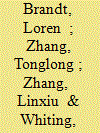| Srl | Item |
| 1 |
ID:
156608


|
|
|
|
|
| Summary/Abstract |
Through two rounds of land contracting, rural households have been allocated a bundle of rights in land. We observe significant differences across villages in the amount of land to which villagers retain a claim and the institutional mechanisms governing the exchange of land rights. This study reveals the perpetuation and expansion of non-market mechanisms accruing to the benefit of village cadres and state officials and only limited emergence of market mechanisms in which households are primary beneficiaries. It identifies factors in economic, political and legal domains that incentivize and enable state officials and local cadres to capture returns from use of land. Relatedly, the study finds differences in conflict over property-rights regimes. Drawing on a pilot survey carried out by the authors in November of 2011 in Shaanxi and Jiangsu provinces (192 households in 24 villages), this paper seeks to explain heterogeneity and change in property-rights regimes over time and across space.
|
|
|
|
|
|
|
|
|
|
|
|
|
|
|
|
| 2 |
ID:
147623


|
|
|
|
|
| Summary/Abstract |
This paper evaluates the impact of village-level land reallocations in China on household economic outcomes. The primary objective is to analyze the effect of short-term differences in tenure security in the year of a reallocation, employing the past history of land shifts as a source of exogenous variation in current tenure security. The results show that a decrease in the probability of losing the current plot yields an increase in agricultural inputs and production with no change in non-agricultural investments, conditional on household fixed effects that control for any unobserved and time-invariant characteristics of the household. This suggests that even small increases in the security of tenure enjoyed by households could yield benefits in terms of greater agricultural output.
|
|
|
|
|
|
|
|
|
|
|
|
|
|
|
|
| 3 |
ID:
147500


|
|
|
|
|
| Summary/Abstract |
In the present paper, the debate on China's growth sustainability is first revisited by highlighting the importance of total factor productivity (TFP). China's TFP performance is then assessed by applying the Jorgensonian aggregate production possibility frontier framework to the latest version of the China Industry Productivity (CIP) database. We find that of China's 8.9-percent annual GDP growth over the period 1980–2012, 7.0 percentage points (ppts) could be attributed to the growth of labor productivity and 1.9 ppts to the increase in hours worked. Nevertheless, the labor productivity growth is found to be heavily dependent on capital deepening (5.7) rather than TFP growth (0.8). Notably, the TFP growth turned negative over 2007–2012, which brings into question the sustainability of China's growth. Besides, industries that are less prone to state intervention show faster TFP growth than those controlled by the state. Incorporating the Domar aggregation scheme into our model, we further reveal that two-thirds of the TFP growth originates from within industries and the remainder is attributed to a net factor reallocation effect in which labor plays a positive role, whereas capital appears to behave irrationally. Finally, using a revised Maddison–Wu approach to address the potential flaws in official statistics, we arrive at an annual growth rate of 7.2 percent, or 1.7-ppts slower than the 8.9 percent obtained based on the CIP data reconstructed using the official national accounts.
|
|
|
|
|
|
|
|
|
|
|
|
|
|
|
|